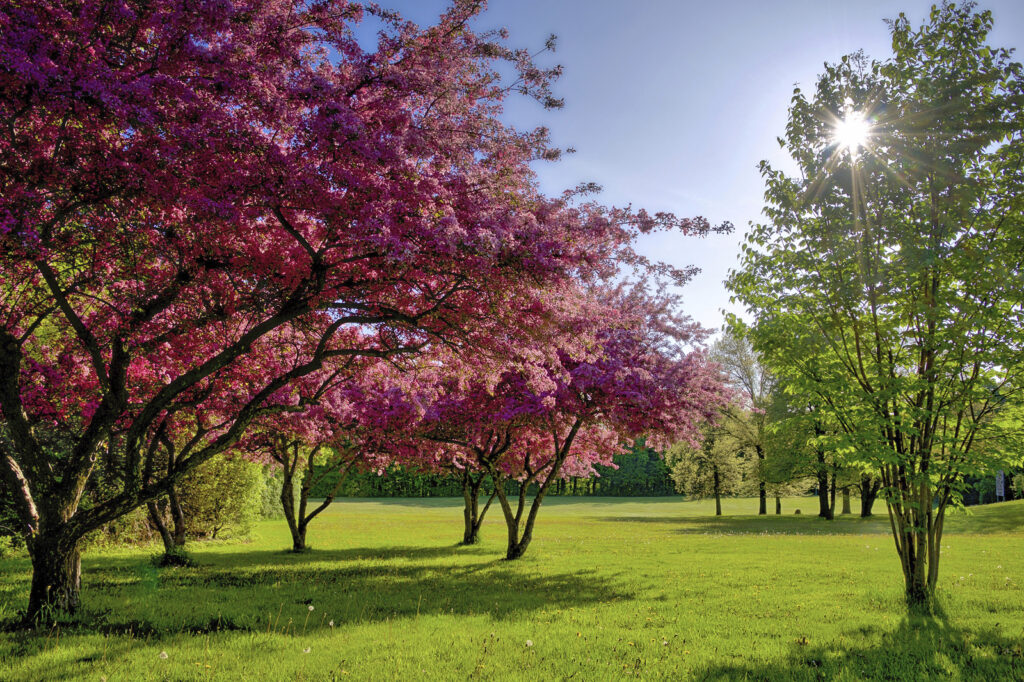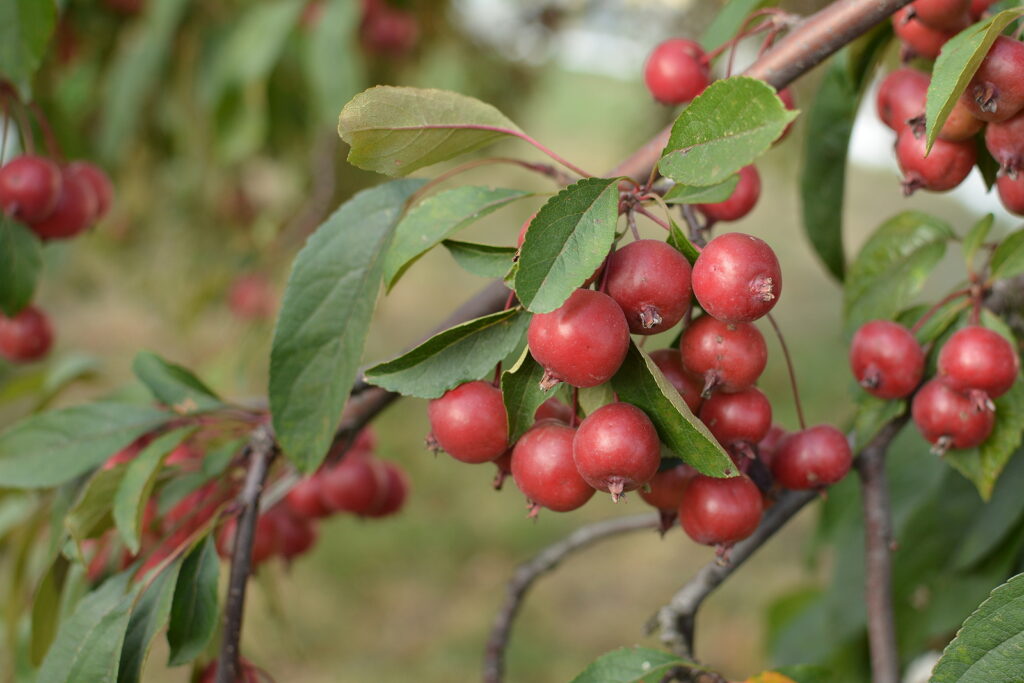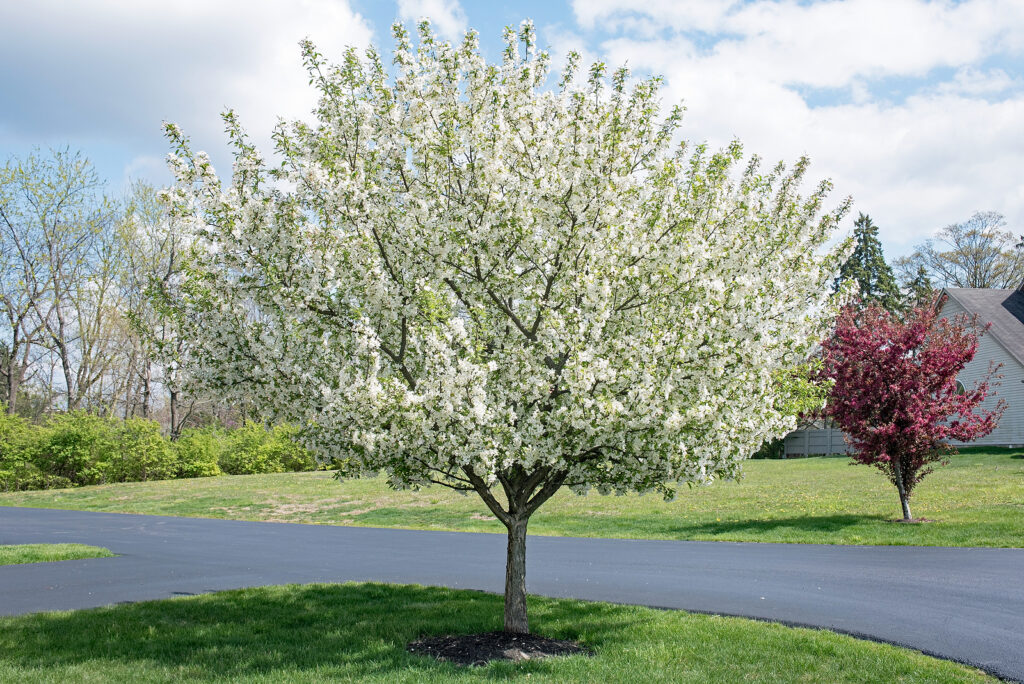The flowering crabapple is a beautiful, disease-resistant tree with horizontal branches and a dense rounded head. Crabapples grow 20 to 30 feet tall and wide. In spring crab apples are covered with clusters of deep reddish-pink flower buds that open to 1-inch-wide fragrant pink flowers that fade to white.
There are many crabapple cultivars in forms including rounded, spreading, vase-shaped, and columnar. Crabapples are disease-resistant. Red, orange, or golden-yellow fruits follow the blossoms. Fruits persist on bare winter branches and are not messy.
Crabapples belong to the Malus genus which includes about 35 species of deciduous trees and shrubs from Asia, Europe, and North America. Apples belong to the Malus genus.
Both apples and crabapples have five-petaled blossoms with 15 to 20 stamens in the center. Crabapples and apples commonly begin blooming before the leaves unfold in spring.
Asian crabapple species are usually preferred for ornament.

Get to know Crabapple
- Plant type: Deciduous tree
- Growing Zones and range: Zone 4 to 8
- Hardiness: Hardy
- Height and spread: To 20 feet (6m) tall and slightly wider, varies according to variety
- Foliage: Pointed oval, dark-green to purple leaves sometimes lobed to 3 inches long, often fuzzy; fall color is usually not notable
- Flowers: Masses of single, semi-double, or double flowers with a musky fragrance are usually deep pink but also white and red; flowers usually appear before leaves unfurl in spring; flowers are followed by tiny red or yellow apples in summer; fruit hangs on trees until after leaves have dropped.
- Bloom time: Spring; many cultivars bloom heavily only in alternate years.
- Uses: Specimen tree, lawn tree, shade tree for small gardens; dropping fruit can be a problem if crab apple is planted near a patio or sitting area or driveways; crabapples can be rained as espalier.
- Common name: Crabapple
- Botanical name: Malus floribunda
- Family: Rosaceae
- Origin: Asia, Europe, North America

Where to plant Crabapple
- Plant crabapple in full sun.
- Plant crabapple in deep, humus-rich, moist, well-drained, slightly alkaline soil.
- Crabapples are more tolerant of wet soil than flowering cherries.
- Best grown in areas with good air circulation.
- Crabapples do not grow well in humid summer regions; select varieties bred for disease resistance.
When to plant Crabapple
- Plant bare-root crabapples in late winter or early spring.
- Plant container-grown plants in spring or autumn.

Planting and spacing Crabapple
- Space crabapples 15 to 20 feet (4.5-6m) apart
How to water and feed Crabapple
- Keep the soil evenly moist.
- Fertilize crabapples by spreading aged compost to the drip line at least once a year

Crabapple care
- Prune crabapple after flowering.
- Prune to keep the center of the plant open to light and air to reduce disease problems.
- Remove water sprouts–non-blooming, thin twigs growing straight up from main branches; remove water sports in mid-to-late winter.
- Rake fallen leaves and fruit to help control apple scab disease.
- Watch for fireblight; removed diseased wood right away.
Crabapple common problems
- Avoid overfeeding which can result in succulent growth which can attract aphids and other insects.
- Avoid planting crabapple near eastern red cedar (Juniperus virginiana); this will reduce the possibility of rust disease.
- Crabapples are susceptible to fireblight, apple scab, and powdery mildew; select disease-resistant varieties especially in southern, warm-winter regions.
Crabapple propagation
- Graft in spring.
- Take softwood cuttings to root in late spring.

Crabapple varieties to grow
- Malus baccata, Siberian crabapple: Tall spreading rounded-head tree grows 20 to 50 feet tall with pink buds that open to creamy white flowers; cultivars include: ‘Columnaris’ columnar growth to 30 feet; has creamy white flowers. ‘Jackii’ resists scab. ‘Walters’ pink buds open to white flowers; gold fruits; grows to 30 feet. ‘Adams’ has deep reddish-pink buds and crimson flowers; grows to 25 feet. ‘Indian Summer’ light magenta flowers; grow to 18 feet tall. ‘Prairiefire’ rounded form to 20 feet tall; purple-red flowers. ‘Weeping Candied Apple’ weeping habit grows to 15 feet; large crimson flowers.
- M. coronaria, wild sweet crabapple: Open habit and fragrant white flowers; Zones 4-8.
- M. floribunda, Japanese flowering crab apple: Beautiful, a disease-resistant tree with horizontal branches and dense rounded head; grows 20 to 30 feet tall and 30 feet wide; clusters of deep reddish-pink flower buds that open into 1-inch fragrant pink flowers that fade to white; blooms last 2 weeks in early to mid-spring; yellow fruits in fall; excellent resistance to Japanese beetles.
- M. hupehensis, tea crab apple: Graceful, vase-shaped, open-branches tree grows 20 to 25 feet tall and wide; deep pink flower buds open to blush pink blossoms that fade to white; yellow fruits with rosy bush in fall; high resistance to scab disease.
- M. prunifolia: Produces clouds of white flowers in spring and bright dangling red fruit in autumn.
- M. sargentii, Sargent crabapple: Small, mounding tree to 15 feet tall; small moundlike habit with a single trunk, often grafted to a 6-foot trunk; pale pink flower buds open to 1-inch wide white flower; bright red fruits in autumn; use in foundation plantings; cultivars include ‘Firebird’, ‘Pink Princess’ and ‘Rosea’.
Flowering crabapples frequently asked questions
Q: Can you recommend a few decorative crabapple trees?
A: Arnold crabapple (Malus floribunda arnoldiana) has pink and white blossoms and yellow fruit. Carmine crabapple (M. atrosanguinea) has red-purple-pink blossoms and red fruit. Toringo crabapple has pink to blush flowers and orange-yellow fruit. Sargent crabapple (M. sargenti) has white blossoms and dark red fruit.
Q: Where can I place a flowering crabapple in my landscape?
A: Place the flowering crabapple where you can enjoy the blossoms in spring and light shade in summer. Crabapples can fit in small spaces; they grow just 10 to 15 feet wide and are not more than 20 feet tall. Crabapples require little to no care.
Q: When is a good time to plant or transplant a crabapple?
A: Plant crabapples before the leaves develop in spring or after they fall in autumn. Plant crabapples in good soil with good drainage and plenty of sunlight.
Q: Do crabapples need special care?
A: Crabapples need little to no special care. You can spray them with dormant oil in winter and early spring if you have a scale outbreak.















